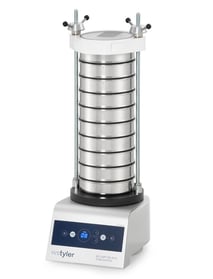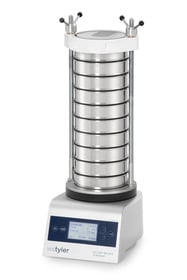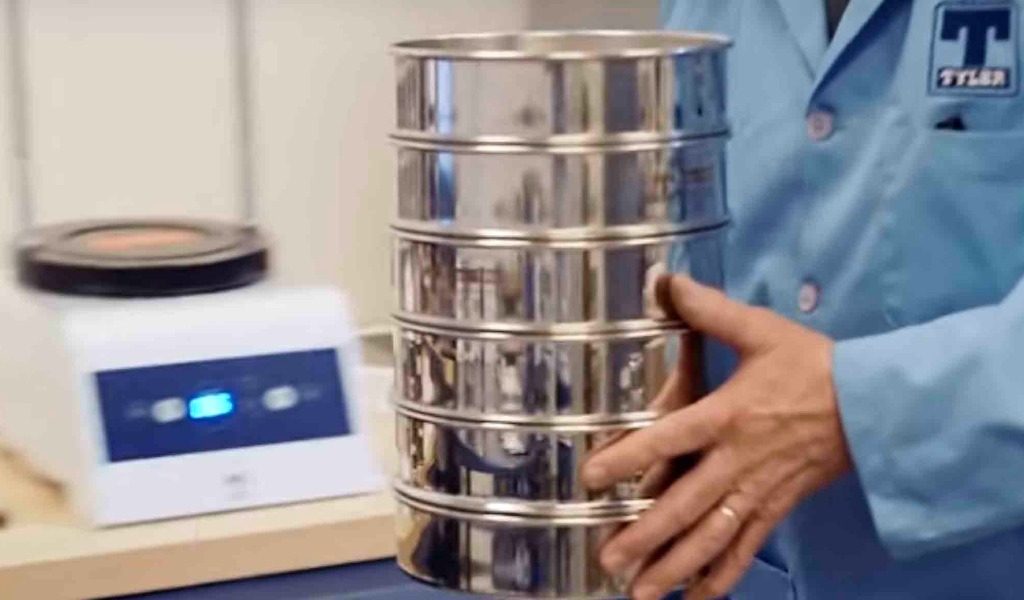W.S. Tyler RO-TAP® E Pure vs RO-TAP E Premium
For decades, test sieve analysis has been the gold standard of gathering accurate and repeatable particle analysis results. However, through the years, little innovation was ever made.
Fast forward to the 90s, when technology began to integrate into our everyday lives. It was during this time when electromagnetic sieve shakers began to redefine the test sieve analysis process.
But with such as dramatic change, we began to see dozens of electromagnetic sieve shakers, such as the W.S. Tyler RO-TAP® E Pure and W.S. Tyler RO-TAP® E Premium, begin to hit the market. This, in turn, made the process of determining if an electromagnetic sieve shaker is right for you and selecting the right one daunting.
Fortunately, W.S. Tyler has over 30 years of experience working the electromagnetic sieve shakers and is here to guide you towards selecting a device that is right for you.
With that said, this article was designed to provide insight into how the RO-TAP E Pure and RO-TAP E Premium compare to one another and will cover:
- What the RO-TAP E Pure is
- What the RO-TAP E Premium is
- How the two devices compare
- Determining which device is right for you
What Is a RO-TAP E Pure?

The W.S. Tyler RO-TAP E Pure is an electromagnetically driven sieve shaker. It was designed to mirror the functions of standards mechanical sieve shakers, such as the W.S. Tyler RO-TAP® RX-29.
What Is a RO-TAP E Premium?

The W.S. Tyler RO-TAP E Premium is an electromagnetic sieve shaker that mimics the functions of a RO-TAP RX-29 in a similar way as the RO-TAP E Pure. The most significant difference is in the program on the control panel, which allows the user to go in and set the amplitude and motion stop intervals.
How Do the RO-TAP E Pure and RO-TAP E Premium Compare?
Picking the right particle analysis equipment is integral to yielding accurate and repeatable results. When looking at the RO-TAP E Pure and the RO-TAP E Premium, you must take test sieve compatibility, cost, noise level, installation, operation, and maintenance into consideration.
Test Sieve Compatability
RO-TAP E Pure
The RO-TAP E Pure is designed to test 8-inch test sieves. The number of sieves in a stack is determined by the frame height.
When using full-height test sieves, the test sieve stack can consist of nine test sieves with a pan. On the other hand, if half-height test sieves are being used, the RO-TAP E Pure can hold a test sieve stack with 15 sieves and a pan.
RO-TAP E Premium
Much like the RO-TAP E Pure, the RO-TAP E Premium is designed to hold 8-inch test sieves. Again, this means a test sieve stack can consist of nine full-height test sieves with a pan or 15 half-height test sieves with a pan.
Cost
RO-TAP E Pure
When investing in the RO-TAP E Pure, you can expect to pay $6,393.71, depending on your needs. The main contributing factor to this cost is the raw material needed to construct it.
For this reason, the price of the RO-TAP E Pure may change based on the market.
RO-TAP E Premium
The RO-TAP E Premium carries a price tag of $7,536.32. The biggest factor in the price difference from the RO-TAP E Pure is the materials used for the digital interface and the research and development that went into creating the user experience.
Noise Level
RO-TAP E Pure
As the RO-TAP E Pure does not have all the moving gears and the agitating hammer taps seen with mechanical sieve shakers, the RO-TAP E Pure is a relatively quiet device. At most, the device will produce a buzzing that is loud but not overwhelming.
To put this into perspective, you can talk amongst your staff with ease while the device is running.
That said, the noise you can expect when using this device will vary based on the material you are testing, as the induvial particles will rattle while hitting the sides of the sieves and fall through the mesh.
RO-TAP E Premium
The RO-TAP E Premium is much like the RO-TAP E Pure in the fact that it doesn't make a lot of noise. Again, the noise level while testing will vary based on the material in your test sieve stack.
Now, with the RO-TAP E Premium, in particular, the noise that is produced will also vary on your SOPs. With the customization of amplitude in mind, remember: the higher the amplitude, the louder the device will be.
Installation
RO-TAP E Pure
The RO-TAP E pure is relatively light compared to other sieve shakers, so one person can remove it from the box and place it on a secured surface. That said, for your safety and the safety of your lab staff, we recommend two people carry out any transportation of the device.
This particular device doesn't tend to shift while operating like most mechanism sieve sharks, so it can simply be placed on a sturdy table away from the edge.
No bolting is necessary.
From here, simply insert and tighten the two guide rods on the device, secure the sieve cover, and plug it into a reliable and adequate power source.
RO-TAP E Premium
Out of the box, installing the RO-TAP E Premium can be done with the same installation process of RO-TAP E Pure. A single person can lift it, place it on a steady table, secure the guide rods and sieve stack cover, and plug it into an adequate power source.
Operation
RO-TAP E Pure
Under the hood of the RO-TAP E Pure, you will find an industrial magnet attached to a spring mechanism. This mechanism is used to displace a sieve plate located below the test sieve stack in place of the prominent hammer seen with traditional sieve shakers.
This magnetic receives a charge, causing the spring to compress and decompress rapidly. This, in turn, creates an elliptical motion that helps break down particle agglomeration.
Now, to compensate for not having the brute force hammer taps of typical sieve shakers, the RO-TAP E pure incorporates motion stop intervals that allow the particles to settle and find the openings of the test sieve cloth. So the machine will run for 30 seconds then stop for 5 seconds.
To that end, the RO-TAP E Pure features two amplitude settings: a coarse setting and a fine setting. These correlate to the characteristics of the material being tested.
NOTE: Regardless of which device you choose, you will want to conduct an end-of-sieving analysis to ensure you get that optimal separation time that you are looking for.
RO-TAP E Premium
When it comes to how the RO-TAP E Premium agitates sample material to help the particle find the openings in the sieve cloth, there is no difference compared to the RO-TAP E Pure. The fundamental differences are in the user experience.
Rather than limiting the user to a coarse and fine amplitude setting, the RO-TAP E Premium features a control panel that leaves the testing amplitude open to the customer. This allows you to take a deep dive and fine-tune your testing process.
That said, you can store your settings directly on the device as SOPs.
This means that if you have three different products with three different amplitude requirements and three different time settings, you can program the device to minimize user error.
NOTE: It is important that all lab staff that will come into contact with the device are aware of correct testing parameters. If the testing settings are tampered with too much or the wrong SOP is used, you will not get an accurate particle size distribution curve.
Maintenance
RO-TAP E Pure
There is little to no maintenance involved when using the RO-TAP E Pure. The device doesn't really have gears, timing belts, or any other moving parts known to wear in other devices; you shouldn't expect too much maintenance.
That said, you will want to keep the guide rods clean. Doing so will prevent the bolts that secure the test sieve stack and sieve cover from slipping.
RO-TAP E Premium
Maintaining the RO-TAP E Premium is again minimal. Just handle the device with care, and be sure to keep the guide rods clean of any debris to prolong the device's lifespan.
Which Electromagnetic Sieve Shaker Is Right for Me?
As you can probably tell, the RO-TAP E Pure and RO-TAP E Premium an identical in many ways. The one true difference is the level of customization that the devices provide.
With both devices designed to test 8-inch test sites, the range of testable particle sizes is two inches down to 20 microns regardless of which one you choose.
Now, if you run a simpler operation where you are testing the same material and are seeking a device that is quieter than traditional mechanical sieve shakers, the RO-TAP E Pure may make the most sense. However, if you run a more complex operation that tests a variety of material, introduce new material to your process regularly, or are looking to create a lab setting that is fully tailored to your needs, the RO-TAP E Premium may deliver the functionality you need.
Electromagnetic or Mechanical Sieve Shaker? That Is the Question!
The W.S. Tyler RO-TAP E Pure and RO-TAP E Premium are both electromagnetic sieve shakers that, for more the part, carry out the particle size analysis in the same way. The RO-TAP E Pure provides simplified preselected amplitudes that make for a straightforward process, whereas the RO-TAP E Premium grants operators full customization to create a process tailored to their specific needs.
Now, just because these devices utilize more technology than traditional sieve shakers doesn't mean they are any better or worse. Figuring out whether an electromagnetic sieve shaker or mechanical sieve shaker requires you to sit down and analyze the feather and functionalities have to offer.
Over the past several decades, W.S. Tyler has witnessed firsthand how both our mechanical RO-TAP Sieve Shakers and electromagnetic RO-TAP E sieve shakers have helped customers in a wide range of applications. We strive to share these experiences with the industry in hopes of making the process of integrating particle analysis equipment more manageable and less intimidating.
To that end, the following article was written to better illustrate how traditional mechanical sieve shakers compare to electromagnetic sieve shakers and give you a better idea of which one is right for you:
About Ronnie Brown
Ronnie is the Content Writer for W.S. Tyler and has four years of experience as a professional writer. He strives to expand his knowledge on all things particle analysis and woven wire mesh to leverage his exceptional writing and graphic design skills, creating a one-of-a-kind experience for customers.





